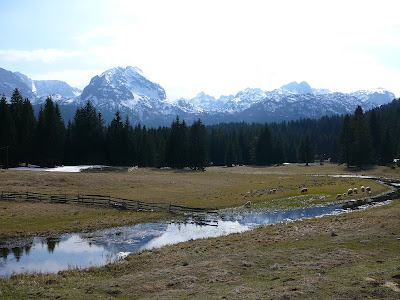


After we last posted, we took the ferry to Santorini, which is probably the most visited of all the Greek islands ( I made that up, but I imagine it to be true, so go with me). We rented a car with the other couple we were travelling with and spent an entire day driving around seeing the island, which turned out to be a great idea because we got to see everything and it didn't cost a whole lot. It is a really beautiful place.
I'm already out of adjectives to use to describe the great stuff we are seeing, so from now on just assume everything is great/cool/amazing/incredible unless I say it's crappy.
Unfortunately, the weather hasn't been the greatest, it was kind of cold in the islands while we were there. It wasn't snowing or anything, but there wasn't tons of sun, and we had to wear long sleeves the whole time. Kind of goes against how you would picture the Greek islands, but I guess everyone has winter.
After Santorini, we went to Naxos, which is the biggest of the Cycladic islands (the group were hopping around). It is extremely mountainous, and all the roads are constantly winding around some mountain, which made for some excellent scenery. Again we spent a whole day just driving around the island, seeing whatever there was to see, but mostly just seeing little villages and enjoying the coastal and mountain views.
We were scheduled to take a midnight ferry to Ikaria, which is a much smaller island to the east of Naxos. After trying to kill a few hours waiting for midnight to come, we stood at the port for 2 hours in the cold because the ferry was very late. We ended up arriving in Ikaria at 7 am, when we were supposed to be there at 3:30. Surprisingly, this was the first time the boats were not on time. After going to sleep for a few more hours, we just wondered around the main town there, enjoying how quiet it is. One guy in town even told us not to tell anyone about the island so that the number of tourists stays as low as it has been. So don't tell anyone, okay?
That night we went and sat in a natural hot spring, which is one of the things Ikaria is famous for, there are many hot springs. The following day we again rented a car and drove around. I think this was probably the best drive I have ever been on. The island is small, has mountains down its spine, and the views from everywhere were great! We stopped in some great little villages as well as doing a short hike to have a picnic lunch on the trails. Beats eating in the PATH any day.
That night we took an overnight ferry back to Athens, where we boarded a train and headed for the north of Greece, a place called Meteora.
It's a beautiful place as well. There are monestaries perched on top of the mountains that overlook the village where we stayed. We hiked through the forest up to the first 2, but as we were eating our lunch it started to rain pretty hard, so we had to go back into town. After walking for an hour and getting pretty damn wet, we found a coffeeshop to take shelter in. The rain kind of ruined our day there, but at least we got to see some of it.
Right now we are in Albania! Finally made it! The people we've met so far have been really nice, so we're happy with that. Unfortunately this internet isn't so fast, so I can't put up too many pictures. Sorry.








































